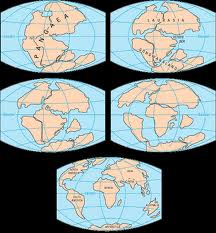Definition: Continental Drift
- It is the theory that the earth’s continents are constantly in motion and at one time they all collided together to form one massive
 continent about 300 million years ago!
continent about 300 million years ago! - Pangaea (meaning “all lands”) began to break up and drift apart.
Founder of the Continental Drift Theory
- Alfred Wegener came up with the idea in the early 1900’s.
- He believed that the world shared certain characteristics that proved that at one time the continents were all together.
- Plate Tectonics – Continental Drift
Proof # 1
- Visually, he saw that the continents of Africa and South America would fit together like a jigsaw puzzle.
Proof # 2
- There were fossils of animals and plants on both continents!
Proof # 3
- There are mountain ranges and structures on different continents that could be lined up if they were one large continent.
- For example: Appalachian and Caledonian Mountains
Proof # 4
- There is proof that ice sheets had once covered the southern portions of South America, Australia, India and Africa – how could this happen in places that are so warm today? Glaciers could have only formed if the continents were close to the south pole.
- However, the theory was debated because scientists wanted evidence to explain how the continents could drift across the earth’s surface.
- …thus the theory of PLATE TECTONICS (1960s)
Plate Tectonics Processes
Divergent
- Found in the middle of the Atlantic Ocean (mid-Atlantic Ridge) .
- New land is created by volcanic activity.
- Divergent
- Convergent
- Found in the Himalayas.
- Fold mountains and trenches are created.
Subduction
- Takes place at convergent boundaries.
- One plate moves underneath the other plate.
- Found on Canada’s West Coast.
- Volcanoes are produced along with earthquakes at great depths.
Subduction – Volcanoes
- The plate moving deeper into the earth melts due to the hot temperature, melting the earth’s crust into liquid form called molten.
- The molten finds a hole in the ground and builds up creating a volcano. Molten inside the volcano is called magma. When the volcano explodes due to gas build up (hot temperatures), magma becomes lava. Lava cools and turns into rock on the earth’s surface.
